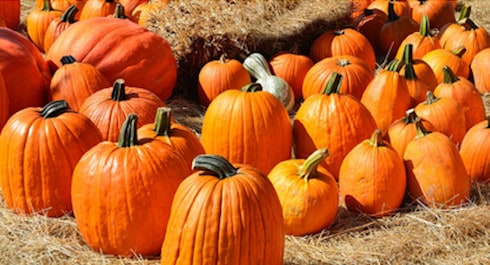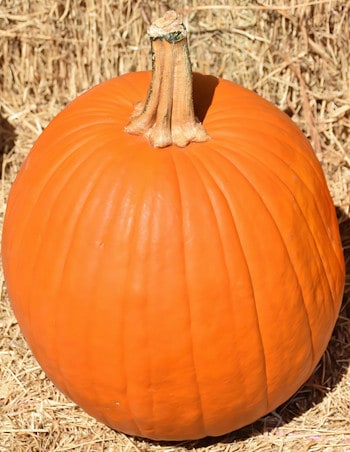Why We’re Excited for the National Pumpkin Day Celebrations
National Pumpkin Day is an important celebration in both the US and Canada because this lovely orange squash is a major part of traditional folklore and the diet.
From September until the end of December, pumpkins are found everywhere, whether in food, ornaments, rituals, or fun!
 Pumpkin is significant in culture as a decorative piece when the summer turns to Autumn (Fall).
Pumpkin is significant in culture as a decorative piece when the summer turns to Autumn (Fall).
You’ll see front porches adorned with all sizes of pumpkins, coloured leaves, and bales of straw or hay.
Of course, once Halloween arrives, there are plenty of carved and lit jack-o’-lanterns to frighten any visitor.
Then, there are not many families that would miss out on their pumpkin pie at Christmas or Thanksgiving. But it is one of those desserts that is readily enjoyed all year round after a big meal, or just as a treat with a a cup of tea.
Further, eating pumpkin has many health benefits and can be dressed up in many ways to make tasty side dishes. It works perfect with all meats, other vegetarian dishes, and of course, all by itself as a comforting snack.
Once you’ve baked or boiled your pumpkin, you will want it nice and smooth for your recipes, so have a look at the selection of handy mini food processors we have highlighted to make the task easier.
There’s just not too much bad to say about pumpkins. In fact, it is not enough to have one day dedicated to it, but there is even a National Pumpkin Month, too. That makes sense, though, because it is the harvest time!
So, in keeping with all the celebrations and traditions, now is a good time to round up all our articles about pumpkins to give you some great ideas and recipes to test.
Easy to make pumpkin spice mix
Easy to make pumpkin soup
Two easy ways to make pumpkin puree
Spiced pumpkin pancakes
Savoury pumpkin and spinach pinwheels
Crunchy crusted nacho pumpkin wedges
Sangkhaya fak thong: Thai coconut pumpkin custard
Pumpkin custard perfect for Thanksgiving
Stuffed pumpkin meatloaf with pork and veal
The humble pumpkin: From edible gourd to Halloween lantern
How to carve a pumpkin for Halloween
When is National Pumpkin Day?
National Pumpkin Day is recognized on October 26th. Needless to say, National Pumpkin Month is October.
Do you need the stalk on the pumpkin?
Yes, you need the stalk on the pumpkin. The stalk is also called the stem or the peduncle. It is needed for 5 simple reasons:

- To prevent the pumpkin from rotting sooner. Keeping the stem intact helps the pumpkin to last longer if are not using it right away.
- For Halloween jack-o’-lanterns. The stalk adds to the decoration of the pumpkin and wouldn’t look right without it.
- If you cut the top off to add a light or candle, you need the stem to hold onto the top for adding and removing.
- For carrying. The bigger the pumpkin is, the harder it is to carry home from the farm or store. Having the stalk to use as a handle is most useful.
- It’s tradition and it’s fun. Seeing the whole pumpkin with the stalk is what harvest is about.
Is pumpkin a fruit or vegetable?
Although we eat pumpkin as both a fruit and a vegetable, in botany, it is considered a fruit. It is part of the Cucurbitaceae family and comes in many varieties, sizes, and colours. And whilst we tend to eat it in many savoury dishes with our meal because it is not too sweet, pumpkin is in fact, a fruit.
If you like to bake fancy pumpkin cookies, take a peek at the cutest cookie cutters to make your cookies more fun to eat and show!
How long can canned pumpkin stay good in the fridge?
Canned pumpkin can stay good in the fridge for four days, as long as it is stored in a container with a proper lid.
To find the best containers to store your own pumpkin or store-bought canned, we’ve done a set of reviews to help you out.
In fact, canned pumpkin is a really easy way to do your baking since you don’t have all the work of picking out a pumpkin, cleaning it, cutting it up, and cooking it.
And if you buy straight pumpkin, and not pumpkin pie filling, you can use the canned pumpkin in recipes the same as your own cooked pumpkin.
What is pumpkin pie spice?
Pumpkin pie spice is a blend of warm spices that are commonly used in making pumpkin pie, as well as other autumn-time desserts and dishes.
Quick tip for making pumpkin pie:
It can be really messy adding the pumpkin mix to the crust and you can use a cup or a gravy spoon.
But one of the easiest, fastest, and cleanest ways to pour the mixture into the crust is with a ladle. Our reviews on the best soup ladles will surely help you with your pumpkin pie baking.
How to make pumpkin spice
See our full recipe with instructions for pumpkin pie spice.
The mixture for pumpkin pie spice typically includes:
Cinnamon:
This spice, derived from the inner bark of several tree species, serves as the primary ingredient in pumpkin pie spice due to its sweet and woody aroma.
Nutmeg:
This spice comes from the seed of the nutmeg tree and adds a sweet and nutty flavor with hints of clove.
Ginger:
Ground ginger root provides a spicy, slightly peppery kick.
Cloves:
Ground from the flower buds of the clove tree, cloves add a strong, sweet, and aromatic flavor.
Allspice:
Despite its name, allspice is a single spice derived from the dried berries of the Pimenta dioica tree. It has flavors similar to cinnamon, cloves, and nutmeg combined.
While most pumpkin pie spice blends contain these core ingredients, some variations might include other spices like mace or cardamom.
The exact proportions can vary based on personal preference. Many people make their own pumpkin pie spice blend at home to tailor it to their own taste.
Quick tip for making your own pumpkin pie spice:
Grinding your own will be fresher, and you can make the exact amount you need so there is less waste.
If you prefer to grind your own spices instead of buying them already ground, you’ll want to read our reviews on the best spice grinders.
How to roast pumpkin seeds
Pumpkin seeds are crunchy, savoury snacks that are not only delicious, but also, nutritious. Packed with essential nutrients and fibre, pumpkin seeds make for a satisfying treat that’s simple to prepare at home.
Roasting or baking pumpkin seeds is easy to do.
- Cut the top off the pumpkin or squash.
- Remove the pulp and the seeds.
- Separate the pulpy strings from the seeds. You might need to soak it all in water to get the seeds to come loose. A colander works great for this, since the water washes away and won’t make the seeds mushy.
- Dry the seeds really well so that they become crispy when roasting.
- Lay the seeds out flat on a cookie sheet.
- Sprinkle your preferred seasonings on the seeds. If you use oil, here are the most healthy oils to use for roasting.
- Pop the sheet in the oven on 350F for roughly 15 minutes. Keep an eye on them so they don’t burn.
- If you don’t eat them all right away, and want to store some, be sure that the seeds are well-cooled before putting in an airtight container to keep them from going rancid.
One way to keep roasted seeds for a longer time is to choose a vacuum sealer. The bags are quite handy for popping in the freezer or cupboard.
What is the historical significance of pumpkins?
The pumpkin traces its origins back to Central America, where ancient cultures were cultivating it as early as 5500 BC. Brought to Europe by explorers in the 15th and 16th centuries, the pumpkin quickly became a staple due to its adaptability and robustness.
For thousands of years, Indigenous Peoples of North America considered pumpkins a crucial food source, often roasting them over open fires or using them to create rich soups. They also dried and wove strips of pumpkins into mats and used the seeds for medicinal and dietary purposes.
What does pumpkin symbolise?
Pumpkins have come to symbolise various aspects of culture and tradition. For many, they represent harvest and bounty. Their vibrant orange hue resonates with the colours of fall, making them symbolic of change and transition.
Examples of pumpkin use in modern day celebrations
National Pumpkin Day is not just a celebration of the pumpkin itself, but also, of the many ways in which it has been embedded in our culture. The month of October is marked by a slew of activities:
Pumpkin carving:
Families come together to carve intricate and often spooky designs into pumpkins. These illuminated creations become the centerpieces of Halloween decorations.
Pumpkin festivals:
Across the nation, towns hold festivals dedicated to celebrating the pumpkin. These festivals often feature pumpkin pie eating contests, pumpkin seed spitting competitions, and the much-awaited giant pumpkin weigh-offs.
Pumpkin in food:
As the weather cools, kitchens warm with the scent of pumpkin pies, breads, cakes, puddings, and lattes. The rich, earthy taste of pumpkin pairs beautifully with spices like cinnamon, nutmeg, and cloves. Its versatility means it can be found in both savoury and sweet dishes.
Pumpkin crafts:
For the artistically inclined, pumpkins can be painted, bedazzled, or transformed into any number of crafts.
Pumpkins and animals:
Children and adults alike can’t wait to watch their favourite animals get their pumpkin treats. Many zoos offer the wild animals whole pumpkins as part of their enrichment programs. Being able to visit the zoo or watching the online videos is a fun activity.
Plus, many people throw their pumpkins into area woods so that the animals have them to eat. Of course, the seeds can grow new pumpkins for the next season.
National Pumpkin Day is truly an occasion to educate people about composting pumpkins or using them as animal feed, ensuring that they don’t go to waste.
Final note on National Pumpkin Day
National Pumpkin Day, though a newer celebration, is rooted in age-old traditions and practices. It’s a day to honour a fruit that has been an integral part of human history for thousands of years.
Although we officially recognise the pumpkin in October, the truth is it is very important from September until the end of December. It features as a major cooking ingredient in so many dishes and recipes.
So, whether you indulge in a slice of pumpkin pie, carve a spooky face into a pumpkin, or simply enjoy its vibrant colour on a crisp fall day, remember to celebrate the heritage and versatility of this bountiful icon.